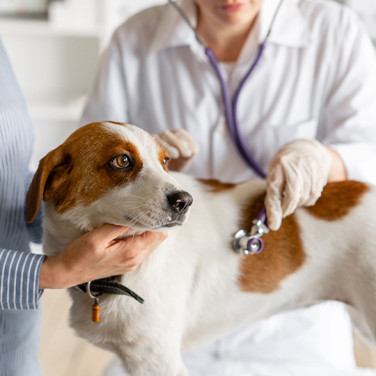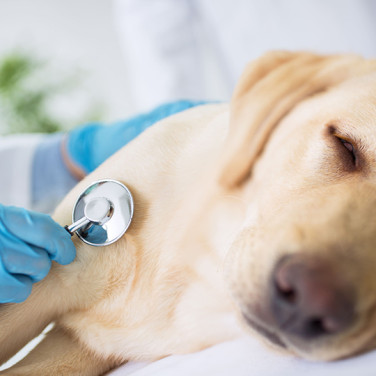DISEASES
Intestinal Intussusception in Dogs - Causes, Symptoms, and Treatments
페이지 정보
본문


What is intussusception in dogs?
Intussusception is a condition that occurs when one part of the intestine is twisted and rolled inside another part of the intestine, causing discomfort and potentially intestinal obstruction. This can happen at any point in the small or large intestine but typically occurs in the middle of the small intestine or at the junction of the small and large intestines. This condition can interrupt the normal flow of food through the digestive tract, resulting in symptoms such as sudden vomiting, diarrhea, loss of appetite, and lethargy. It is more commonly seen in large dogs and young animals with weakened immune systems. If intussusception is suspected, it is important to seek prompt veterinary care to prevent serious complications such as intestinal obstruction, which may require surgical intervention.
What causes intussusception in dogs?
Intestinal intussusception is a type of bowel obstruction that commonly occurs in young puppies and primarily arises from underlying gastrointestinal diseases such as intestinal parasitic infections, ingesting foreign bodies, acute inflammation, inflammatory bowel disease, and metabolic disorders. The obstruction can be triggered by an increase in intestinal motility, making any condition associated with increased gastrointestinal motility a risk factor for developing intussusception. Leptospirosis is one example of an infectious disease linked to intestinal intussusception in dogs. 70% of cases of intussusception occur in young dogs under a year of age.
Causes that can cause intussusception include:
- Intestinal parasites (hookworms, whipworms, and roundworms)
- Bacterial or viral infection (giardia, salmonella, distemper, parvovirus, etc.)
- Ingesting a foreign body (bones, plastic toys, etc.)
- Sudden change in eating habits
- Intestinal tumors
- Intestinal related surgery
- Severe intestinal contractions
What are the symptoms of intestinal intussusception in dogs?

Intestinal intussusception in dogs can manifest as acute or chronic clinical signs that vary in severity. Vomiting and diarrhea are the most frequently observed symptoms, and their presentation may differ depending on the location of the intestinal folding. In addition, if left untreated, intussusception can cause intestinal obstruction, leading to further health complications. Even if the condition heals independently, symptoms may still appear intermittently.
The main symptoms of intussusception in dogs are:
- Vomiting or blood in vomit
- Regurgitation
- Diarrhea or blood in stool
- Straining to defecate
- Abdominal pain (crying, whimpering, refusing to lie down, praying position)
- Loss of appetite
- Lethargy
- Weight loss
- Dehydration
- Shortness of breath
What are the risks of intussusception in dogs and when to see a vet
The risk of intestinal intussusception can differ depending on its location. In particular, German Shepherds may be more prone to gastroesophageal intussusception in the gastroesophageal region, which can cause severe clinical symptoms. If your dog has undergone a spinal fusion procedure, they may be at a higher risk for complications such as intestinal obstruction. It is recommended to visit a vet if you suspect any signs of intestinal obstruction or intussusception before symptoms worsen.
Home treatments for intussusception in dogs
Although intussusception can sometimes heal spontaneously, it often recurs; therefore, surgical correction is typically recommended. Following surgery, it is advised to feed digestible wet food and restrict daily activities until full recovery has passed. Additionally, adequate fluid intake is crucial to prevent dehydration due to symptoms of intussusception.
Diagnosing intussusception in dogs

When diagnosing an intestinal intussusception, a physical examination, including abdominal palpation, can easily identify a sausage-shaped lump. While abdominal radiography can confirm which pattern of obstruction, abdominal ultrasound is an excellent tool for confirming intussusception, particularly in cases of partial obstruction. A veterinarian may perform an X-ray on your pet’s blood vessels or endoscopy, but in most cases, a diagnosis can be made with an abdominal ultrasound. To assess overall health and guide stabilizing treatments, blood tests may also be performed to determine if your pet is healthy enough for treatment.
Treatment for intestinal intussusception in dogs
When treating intussusception, it is crucial to address the underlying cause, as recurrence is common. Surgery is often necessary, during which the overlapped section of the intestine is identified and released, and in severe cases, resection may be required. To reconnect the cut ends, intestinal anastomosis is also performed. Enteropexy can help prevent recurrence by securing the intestine to the abdominal wall.
While recovery takes place, it is recommended to feed your pet easily digestible wet foods. During hospitalization, dehydration, and electrolyte imbalances are closely monitored, and additional antibiotics may be prescribed if needed. The surgical approach involves making an incision into the abdomen to examine the affected organs, and if the bowel is in good condition, it can be separated through massage. However, in most cases, the affected portion of the bowel must be removed and reconnected surgically. Recurrence can be prevented by suturing adjacent loops of the bowel together. If the intussusception subsides spontaneously, surgery may not be necessary, but recurrence is likely without surgical intervention. Intravenous fluids, electrolytes, and plasma or hetastarch may be administered while the dog is monitored in intensive care and given pain relief medication.
What is the prognosis for the treatment of intussusception in dogs
Intussusception has a relatively good prognosis after surgery, and in some cases, it may even resolve independently without the need for surgical intervention. However, recurrence rates can be as high as 15%, especially if the underlying cause of the intussusception is not properly addressed. It's worth noting that recurrence rates are higher when the intussusception is manually reduced as opposed to undergoing surgical correction. The prognosis for a dog with intussusception depends on several factors, including the duration, extent, and severity of the condition. Dogs with multiple areas requiring bowel resection may have a poorer prognosis due to the shortened length of the remaining intestine.
Preventing intussusception in dogs
The only cause of Intestinal intussusception that can be prevented is infections such as parvovirus which can be prevented through periodic vaccination.
Find out more about your dog’s symptoms and diseases on the Buddydoc app!

The Buddydoc library is filled with everything you’d want to know about each symptom and disease your pet may experience. If you would like to find out more about the causes, signs, treatments, preventions, and more for your dog’s disease. Try out the Buddydoc app and search for your pet’s symptoms or diseases in the Buddydoc library.













